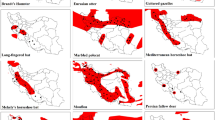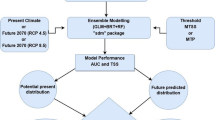Abstract
We assessed the vulnerability of 208 endemic or endangered species in China to the effects of climate change, as a part of the project “Research on China’s National Biodiversity and Climate Change Strategy and Action Plans”. Based on the China Species Information System, we selected comprehensive species as analysis targets, covering taxa including mammals, birds, reptiles, amphibians and plants. We applied nine species distribution models in BIOMOD (a package of R software) to estimate the current (1991–2010) ranges and predicted future (2081–2100) ranges of these species, using six climate variables based on Regional Climate Model version 3 (RegCM3) and A1B emission scenario. The model results showed that different taxa might show diverse potential range shifts over time. The range sizes of half of the species (104 species) would decrease, and those of another half would increase. We predicted that the future remaining ranges (intersection of current and future ranges/current ranges) of 135 species would be less than 50 % of their current range sizes. Species that are both endemic and critically endangered would lose more of their range than others. In summary, the most vulnerable species are currently found on the Qinghai-Tibetan Plateau, in the Hengduan Mountain Range, and southern China. Future action plans dealing with climate change in China should be prepared with consideration for vulnerable species and their habitats.





Similar content being viewed by others
References
Aertsen W, Kint V, van Orshoven J, Özkan K, Muys B (2010) Comparison and ranking of different modelling techniques for prediction of site index in Mediterranean mountain forests. Ecol Model 221(8):1119–1130. doi:10.1016/j.ecolmodel.2010.01.007
Alkemade R, Bakkenes M, Eickhout B (2011) Towards a general relationship between climate change and biodiversity: an example for plant species in Europe. Reg Environ Chang 11:S143–S150. doi:10.1007/s10113-010-0161-1
Araújo MB, New M (2007) Ensemble forecasting of species distributions. Trends Ecol Evol 22(1):42–47. doi::10.1016/j.tree.2006.09.010
Araújo MB, Rahbek C (2006) How does climate change affect biodiversity? Science 313(5792):1396–1397
Beaumont LJ, Pitman AJ, Poulsen M, Hughes L (2007) Where will species go? Incorporating new advances in climate modelling into projections of species distributions. Global Chang Biol 13(7):1368–1385
Breiman L (2001) Statistical modeling: the two cultures. Stat Sci 16(3):199–215. doi:10.1214/ss/1009213726
Ceballos G, Ehrlich PR (2002) Mammal population losses and the extinction crisis. Science 296(5569):904–907. doi:10.1126/science.1069349
China’s National Assessment Report on Climate Change Committee (2007) China’s National Assessment Report on Climate Change. Beijing
Coetzee BWT, Robertson MP, Erasmus BFN, van Rensburg BJ, Thuiller W (2009) Ensemble models predict important bird areas in southern Africa will become less effective for conserving endemic birds under climate change. Global Ecol Biogeogr 18(6):701–710. doi:10.1111/j.1466-8238.2009.00485.x
Conroy MJ, Runge MC, Nichols JD, Stodola KW, Cooper RJ (2011) Conservation in the face of climate change: the roles of alternative models, monitoring, and adaptation in confronting and reducing uncertainty. Biol Conserv 144(4):1204–1213. doi:10.1016/j.biocon.2010.10.019
Cressie N, Calder CA, Clark JS, Hoef JMV, Wikle CK (2009) Accounting for uncertainty in ecological analysis: the strengths and limitations of hierarchical statistical modeling. Ecol Appl 19(3):553–570. doi:10.1890/07-0744.1
del Barrio G, Harrison PA, Berry PM, Butt N, Sanjuan ME, Pearson RG, Dawson T (2006) Integrating multiple modelling approaches to predict the potential impacts of climate change on species’ distributions in contrasting regions: comparison and implications for policy. Environ Sci Policy 9(2):129–147. doi:10.1016/j.envsci.2005.11.005
Dormann CF, Schweiger O, Arens P, Augenstein I, Aviron S, Bailey D, Baudry J, Billeter R, Bugter R, Bukacek R, Burel F, Cerny M, De Cock R, De Blust G, DeFilippi R, Diekotter T, Dirksen J, Durka W, Edwards PJ, Frenzel M, Hamersky R, Hendrickx F, Herzog F, Klotz S, Koolstra B, Lausch A, Le Coeur D, Liira J, Maelfait JP, Opdam P, Roubalova M, Schermann-Legionnet A, Schermann N, Schmidt T, Smulders MJM, Speelmans M, Simova P, Verboom J, van Wingerden W, Zobel M (2008) Prediction uncertainty of environmental change effects on temperate European biodiversity. Ecol Lett 11(3):235–244. doi:10.1111/j.1461-0248.2007.01142.x
Elith J, Graham CH (2009) Do they? How do they? Why do they differ? On finding reasons for differing performances of species distribution models. Ecography 32(1):66–77. doi:10.1111/j.1600-0587.2008.05505.x
Elith J, Graham CH, Anderson RP, Dudik M, Ferrier S, Guisan A, Hijmans RJ, Huettmann F, Leathwick JR, Lehmann A, Li J, Lohmann LG, Loiselle BA, Manion G, Moritz C, Nakamura M, Nakazawa Y, Overton JM, Peterson AT, Phillips SJ, Richardson K, Scachetti-Pereira R, Schapire RE, Soberon J, Williams S, Wisz MS, Zimmermann NE (2006) Novel methods improve prediction of species’ distributions from occurrence data. Ecography 29(2):129–151. doi:10.1111/j.2006.0906-7590.04596.x
Erasmus BFN, Van Jaarsweld AS, Chown SL, Kshatriya M, Wessels KJ (2002) Vulnerability of South African animal taxa to climate change. Global Chang Biol 8:679–693
Fuller T, Morton DP, Sarkar S (2008) Incorporating uncertainty about species’ potential distributions under climate change into the selection of conservation areas with a case study from the Arctic Coastal Plain of Alaska. Biol Conserv 141(6):1547–1559. doi:10.1016/j.biocon.2008.03.021
Hirzel AH, Le Lay G, Helfer V, Randin C, Guisan A (2006) Evaluating the ability of habitat suitability models to predict species presences. Ecol Model 199(2):142–152. doi:10.1016/j.ecolmodel.2006.05.017
Hughes L (2011) Climate change and Australia: key vulnerable regions. Reg Environ Chang 11:S189–S195. doi:10.1007/s10113-010-0158-9
Huntley B, Collingham YC, Willis SG, Green RE (2008) Potential impacts of climatic change on european breeding birds. PLoS One 3 (1):Article No.: e1439. doi:10.1371/journal.pone.0001439
IPCC (2001) Climate change 2001: the scientific basis. Contribution of working group I to the third assessment report of the intergovernmental panel on climate change. Cambridge, United Kingdom and New York, NY, USA
IPCC (2007) Climate change 2007: the physical science basis. Contribution of working group i to the fourth assessment. Report of the intergovernmental panel on climate change. Cambridge University Press, Cambridge
IUCN (2004) IUCN Red List of Threatened Species
Kampichler C, Wieland R, Calmé S, Weissenberger H, Arriaga-Weiss S (2010) Classification in conservation biology: a comparison of five machine-learning methods. Ecol Inform 5(6):441–450. doi:10.1016/j.ecoinf.2010.06.003
Li RQ, Tian HD, Li XH (2010) Climate change induced range shifts of Galliformes in China. Integr Zool 5(2):154–163. doi:10.1111/j.1749-4877.2010.00198.x
Liu JG, Ouyang ZY, Pimm SL, Raven PH, Wang XK, Miao H, Han NY (2003) Protecting China’s biodiversity. Science 300(5623):1240–1241. doi:10.1126/science.1078868
Liu CR, Berry PM, Dawson TP, Pearson RG (2005) Selecting thresholds of occurrence in the prediction of species distributions. Ecography 28(3):385–393. doi:10.1111/j.0906-7590.2005.03957.x
Marmion M, Luoto M, Heikkinen RK, Thuiller W (2009) The performance of state-of-the-art modelling techniques depends on geographical distribution of species. Ecol Model 220(24):3512–3520. doi:10.1016/j.ecolmodel.2008.10.019
McMahon SM, Harrison SP, Armbruster WS, Bartlein PJ, Beale CM, Edwards ME, Kattge J, Midgley G, Morin X, Prentice IC (2011) Improving assessment and modelling of climate change impacts on global terrestrial biodiversity. Trends Ecol Evol 26(5):249–259. doi:10.1016/j.tree.2011.02.012
McRae BH, Schumaker NH, McKane RB, Busing RT, Solomon AM, Burdick CA (2008) A multi-model framework for simulating wildlife population response to land-use and climate change. Ecol Model 219(1–2):77–91. doi:10.1016/j.ecolmodel.2008.08.001
Meynard CN, Quinn JF (2007) Predicting species distributions: a critical comparison of the most common statistical models using artificial species. J Biogeogr 34(8):1455–1469. doi:10.1111/j.1365-2699.2007.01720.x
Ministry of Environmental Protection (2010) 2009 Report on the State of the Environment of China. Beijing
Ministry of Forestry, Ministry of Agriculture (1989) China State Key Protected Animal List. Beijing
Morin X, Thuiller W (2009) Comparing niche- and process-based models to reduce prediction uncertainty in species range shifts under climate change. Ecology 90(5):1301–1313. doi:10.1890/08-0134.1
Niu Z, Zhang H, Gong P (2011) More protection for China’s wetlands. Nature 471(7338):305
Olden JD, Lawler JJ, Poff NL (2008) Machine learning methods without tears: a primer for ecologists. Q Rev Biol 83(2):171–193
Pal JS, Giorgi F, Bi X, Elguindi N, Solmon F, Gao X, Rauscher SA, Francisco R, Zakey A, Winter J, Ashfaq M, Syed FS, Bell JL, Diffenbaugh NS, Karmacharya J, Konare A, Martinez D, da Rocha RP, Sloan LC, Steiner AL (2007) Regional climate modeling for the developing world - The ICTP RegCM3 and RegCNET. Bull Am Meteorol Soc 88(9):1395–1409. doi:10.1175/bams-88-9-1395
Parmesan C, Yohe G (2003) A globally coherent fingerprint of climate change impacts across natural systems. Nature 421:37–42
Patt A, Klein RJT, de la Vega-Leinert A (2005) Taking the uncertainty in climate-change vulnerability assessment seriously. Comptes Rendus Geosci 337(4):411–424. doi:10.1016/j.crte.2004.11.006
Pearson RG, Thuiller W, Araújo MB, Martinez-Meyer E, Brotons L, McClean C, Miles L, Segurado P, Dawson TP, Lees DC (2006) Model-based uncertainty in species range prediction. J Biogeogr 33(10):1704–1711. doi:10.1111/j.1365-2699.2006.01460.x
Phillips SJ, Dudik M (2008) Modeling of species distributions with Maxent: new extensions and a comprehensive evaluation. Ecography 31(2):161–175. doi:10.1111/j.0906-7590.2008.5203.x
Prasad AM, Iverson LR, Liaw A (2006) Newer classification and regression tree techniques: bagging and random forests for ecological prediction. Ecosystems 9(2):181–199. doi:10.1007/s10021-005-0054-1
R Development Core Team (2011) R: A Language and Environment for Statistical Computing. R Foundation for Statistical Computing, Vienna
Root TL, Price JT, Hall KR (2003) ‘Fingerprints’ of global warming on animals and plants. Nature 421:57–60
Schwartz MW, Iverson LR, Prasad AM, Matthews SN, O’Connor RJ (2006) Predicting extinctions as a result of climate change. Ecology 87(7):1611–1615
Segurado P, Araujo MB (2004) An evaluation of methods for modelling species distributions. J Biogeogr 31(10):1555–1568. doi:10.1111/j.1365-2699.2004.01076.x
Sekercioglu CH, Schneider SH, Fay JP, Loarie SR (2008) Climate change, elevational range shifts, and bird extinctions. Conserv Biol 22(1):140–150. doi:10.1111/j.1523-1739.2007.00852.x
Shoo LP, Williams SE, Hero JM (2006) Detecting climate change induced range shifts: where and how should we be looking? Austral Ecol 31(1):22–29. doi:10.1111/j.1442-9993.2006.01539.x
State Forestry Administration, Ministry of Agriculture (1999) China State Key Protected Plant List. Beijing
Thuiller W, Lafourcade B, Araujo M (2009a) ModOperating Manual for BIOMOD
Thuiller W, Lafourcade B, Engler R, Araújo MB (2009b) BIOMOD—a platform for ensemble forecasting of species distributions. Ecography 32(3):369–373. doi:10.1111/j.1600-0587.2008.05742.x
Tsoar A, Allouche O, Steinitz O, Rotem D, Kadmon R (2007) A comparative evaluation of presence-only methods for modelling species distribution. Divers Distrib 13(4):397–405. doi:10.1111/j.1472-4642.2007.00346.x
Wang G, Innes JL, Lei J, Dai S, Wu SW (2007) China’s forestry reforms. Science 318(5856):1556–1557. doi:10.1126/science.1147247
Wiens JA, Stralberg D, Jongsomjit D, Howell CA, Snyder MA (2009) Niches, models, and climate change: assessing the assumptions and uncertainties. Proc Natl Acad Sci USA 106(2):19729–19736. doi:10.1073/pnas.0901639106
Xie Y, Mackinnon J, Li D (2004) Study on biogeographical divisions of China. Biodivers Conserv 13(7):1391–1417. doi:10.1023/B:BIOC.0000019396.31168.ba
Acknowledgments
This work is a part of the project “Research on China national biodiversity and climate change strategy and action plans”, supported by the EU-China Biodiversity Program (ECBP). This study was also supported by the Strategic Priority Research Program of the Chinese Academy of Sciences (XDA05080701) and the Public Welfare Project (201209027) of the Ministry of Environmental Protection of China. We thank anonymous reviewers who provided valuable comments and suggestions.
Author information
Authors and Affiliations
Corresponding author
Electronic supplementary material
Below is the link to the electronic supplementary material.
Rights and permissions
About this article
Cite this article
Li, X., Tian, H., Wang, Y. et al. Vulnerability of 208 endemic or endangered species in China to the effects of climate change. Reg Environ Change 13, 843–852 (2013). https://doi.org/10.1007/s10113-012-0344-z
Received:
Accepted:
Published:
Issue Date:
DOI: https://doi.org/10.1007/s10113-012-0344-z




